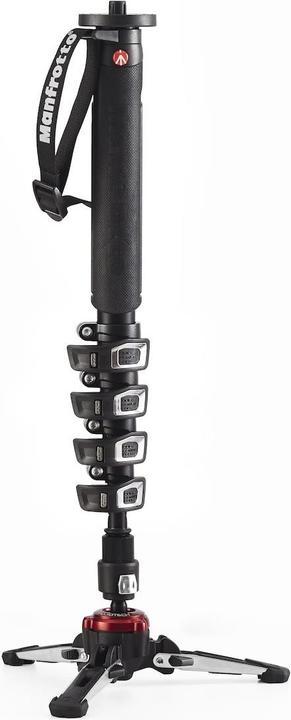

Nikon KeyMission 360: the real deal
Some say the Nikon KeyMission 360 is a disaster, others are won over. Which is true? So I bought this controversial action camera, tested it out and was pleasantly surprised.
The KeyMission is an action camera with which you can take 360-degree shots. Both front and rear, it has a lens and weighs less than 200 grams, including memory card and battery. Each of these lenses has a shooting angle of around 190 degrees. The shots from the two lenses overlap slightly, enabling the camera to capture a 360-degree view. What's unique about the Nikon KeyMission 360 is that it merges the 360-degree images directly into the camera. This means that the videos on the memory card are finished, avoiding tedious post-processing work.
The action camera is equipped with a 23.9Mpx CMOS sensor. Thanks to this sensor, videos can be taken at 4K resolution (4096 x 2160 pixels) with 24 frames per second. What's more, the Key Mission offers a panorama function for high-quality images. It is ideal for "Tiny Planet" images like this photo below:
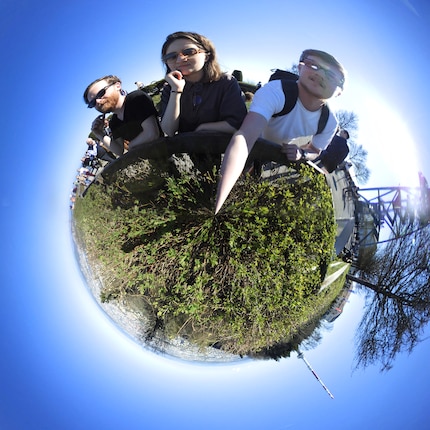
Included in delivery
In addition to the KeyMission 360, a number of accessories are included. The battery needed for operation is also included. This is a traditional Nikon battery, also used in Coolpix cameras. To recharge this battery, Nikon has provided a USB cable with a suitable network adapter. However, the KeyMission can be charged using any traditional microUSB cable.

A ball head is also included in the delivery. This can be mounted on almost any surface using a flat or curved mount. A bit like the GoPro models. But be careful! Nikon has its own system. GoPro plates are not compatible with the KeyMission. However, the Nikon has a standard photo thread that allows you to use all the usual tripods with your KeyMission. In addition to the standard convex lens protectors, Nikon has added flat lens protectors dedicated to diving. These are easily attached using a bayonet system. Admittedly, the camera is waterproof with both variants, but, underwater, the flat version offers better correction of light refraction.
For better protection of the camera against knocks and the like, there's a silicone cover that easily attaches to the KeyMission. Personally, I've always used the camera without a cover. As I don't like the feel of silicone, both attaching the cover to the camera and using it felt a little too uncomfortable. Another goodie included in the delivery is a pair of basic cardboard VR glasses into which you can attach your smartphone. The principle is similar to that of the Google Cardboard.
Also, I've bought myself the Nikon selfie-stick again. I have to say that it fulfils its mission as a stick, but it's not really worth the price. It's overpriced, but it's still useful. As the camera captures 360-degree shots, the tripod is also visible under the camera at the end of the shot. Having a big tripod in the middle of a shot isn't exactly aesthetically pleasing. So I'd recommend this selfie-stick or a one-legged tripod with small legs like the one below:
Finishments
When it comes to the KeyMission's finishes, the renowned Nikon quality shines through. The materials used give a robust feel. So it's not without reason that the camera withstands a fall from up to two metres high. It could certainly withstand more, but I wouldn't test it for that. Still, it's an action camera, which means it'll take a few scratches here and there. As long as these aren't on the lens protectors, I don't see a problem.
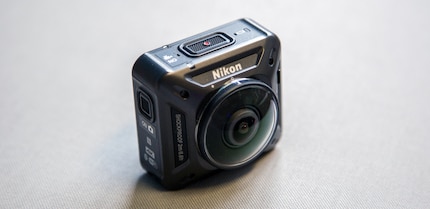
As already mentioned, the KeyMission is waterproof with both lens protectors. It can easily be used at depths of up to 30 metres. According to the manufacturer, it can withstand this depth for up to 60 minutes. You'll certainly never stay underwater for longer than that. Sooner or later, you'll run out of oxygen or battery.
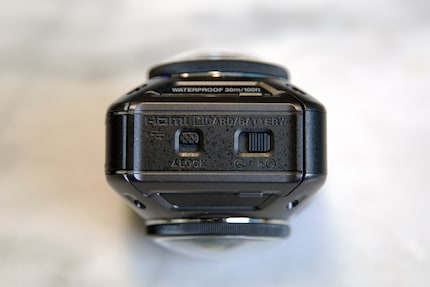
To access the battery or memory card, you need to open the side hatch. This is fitted with a double locking system. So it can't be opened inadvertently. First you push the first latch to the right, then the top latch down. That's it! The hatch is open. As well as the battery and memory card slot, an HDMI input and the plug for recharging the camera are also located under the cover. Using a small switch, you can also disable the KeyMission's WiFi function and put the camera in aeroplane mode.
Functions
The Nikon KeyMission 360 has two buttons. On the top is a rectangular button with a red dot in the centre. If this is pressed briefly, the camera starts recording video straight away. If you just want to turn the camera on, the button must be held down for around three seconds. This is a bit unusual at first, but after a few unintentional video recordings, I quickly got used to it. To turn the camera off after use, you have to hold the button down again for about three seconds. However, you can't really turn the KeyMission off. It only goes into standby mode. To switch it off completely, you need to remove the battery and therefore cut off the power supply completely.
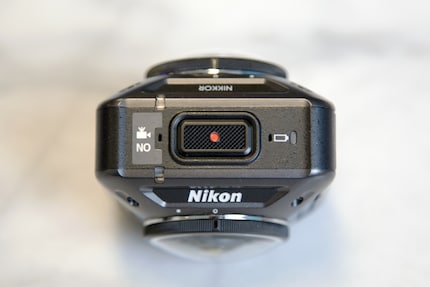
The second button is on the side of the camera. It allows you to control the KeyMission's photo functions. Pressing the button briefly, as with the video button, immediately triggers a photo. Immediately is a bit of an exaggeration. The camera has an automatic shutter release that takes a photo after a certain amount of time. Unlike the other button, you can't turn the camera off.
Connecting to the app
To connect your KeyMission to your smartphone, you need to download the "SnapBridge 360/170" app. The app is compatible with iOS and Android.
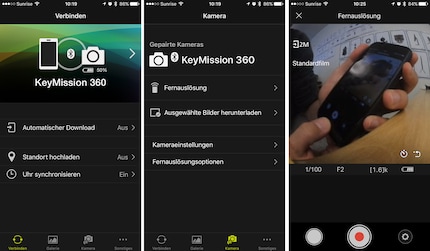
With the SnapBridge app, you can connect your KeyMission to your smartphone via WiFi. Thanks to this connection, you can download your videos and photos directly to your smartphone. Depending on your preferences, recordings can be transferred in a compressed version or in full resolution. Using the app, you can also see a direct preview of the camera. This is particularly useful when you need to orientate the KeyMission. The app also lets you make adjustments to your Nikon. These settings can be made either via the app or the Utility desktop app, but cannot be made on the camera. So if you want to change something, Nikon forces you to download an app or software. This wouldn't be much of a problem if the app worked perfectly. Even though a new Nikon firmware came out not so long ago and made a big improvement to the app, unfortunately the connection doesn't always work.
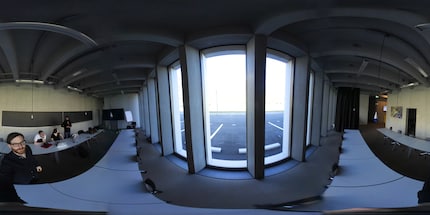
At first, always the same error message appeared when I tried to connect the KeyMission to my iPhone 6s. As I've seen, the app is apparently sensitive to these errors. It turned out that I wasn't patient enough. For the connection to succeed, the app needs a certain amount of time. During this operation, you need to leave your smartphone and camera alone. I assumed that there was a problem and tried to repeat the pairing. That's why my connection didn't work the first time. But if you take your time and follow the step-by-step instructions, the camera and phone connect. After understanding this detail, the connections worked without any major problems.
As for the application, we can say that it works and does its job. However it is still subject to problems with the connection between camera and smartphone. Hopefully Nikon will come up with an update soon to eliminate these issues.
Image quality
The Nikon KeyMission 360 can shoot spherical video with 4K resolution and 24 frames per second. In addition, you have the option of capturing panoramic images with 23.9Mpx.
Video
A great advantage of the KeyMission is that it transforms images directly into spherical video on camera. However, there is always the question of how good the transitions are. After my testing, I can say that the transitions almost always recognise each other a little. Sometimes more, sometimes less. But with a few tricks, you can make the shot more pleasing to the eye. Make sure, for example, that you always orientate the camera correctly: your main motif should always be in the centre of the lens and never to one side, where the two shots are joined together. You can also avoid blurred or distorted shots by leaving enough space on both sides until the next nearest object. I recommend a safe space of one to two metres.
In the video below, conditions were anything but ideal for the KeyMission. I filmed the scene in a room with artificial light and intentionally positioned the camera close to an object. As a result, you can see perfectly how nt the KeyMission handles the transitions of the two lenses.
The KeyMission does not have automatic horizontal orientation. So you need to be careful to position the camera horizontally. Otherwise, you'll get "wavy" shots. You also need to hold the camera as still as possible. The KeyMission does have an integrated image stabiliser, but it didn't really make itself felt. As 360-degree videos are often viewed with VR goggles, shaky and blurry shots can, in the viewer's case, quickly lead to an upset stomach.
The KeyMission records its videos in 4K. The image quality is criticised by many people who wonder how it can be called 4K. It should be noted that 4K resolution is not limited to framing, but is extended to 360 degrees. Admittedly, the videos don't look like those from a 4K camera that only frames 60 degrees. Unfortunately, this prejudice is a problem with all 360-degree cameras, not just the Nikon. Personally, I'm pleasantly surprised by the KeyMission's resolution.
Photos
The advice I gave you above for videos can also be applied to the KeyMission's panoramic photos. If you pay attention to these two or three things, you get good images, with high resolution and good sharpness. I photographed different motifs in different light conditions. It's fair to say that the shots taken outside with enough light are the best. For those taken indoors, there is some graininess, as the small sensor can't take enough light.
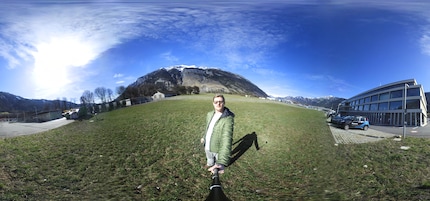
Conclusion
The Nikon KeyMission 360 pleasantly surprised me. 360-degree videos and panoramic photos are a breeze. As the shots are automatically stitched together into a spherical video in-camera, post-processing on the computer is a thing of the past. This makes the KeyMission unique and sets it apart from the competition. For the price, you don't just get a 360-degree camera, you get a real action camera that can easily take a few knocks. 360-degree cameras are still in their infancy, and there are bound to be many improvements in this area over the next few years. Currently, in its price class, the KeyMission is in the top group.
Positive
- high resolution (4K, 23.9MP)
- easy to use
- waterproof and robust
- videos are merged directly into the camera
Negative
- no automatic horizontal orientation
- image stabilisation not strong enough
- application should undergo an update
- assembled shot transitions are visible
You may also be interested in these articles:
I get paid to play with toys all day.

